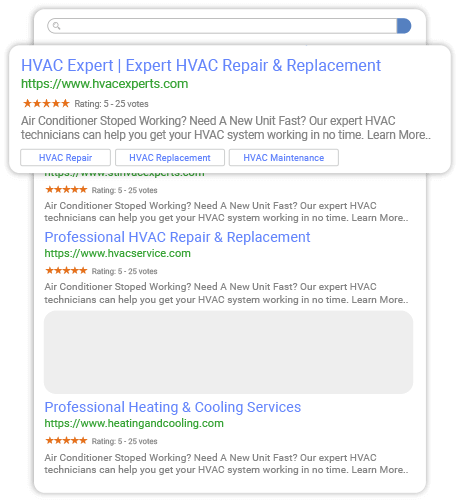With most traffic coming from searches, home service companies need a strong online presence to stay competitive and get leads. Whether running a plumbing, HVAC, landscaping, or foundation repair business, your customers search for your services online and across social media platforms. This is where search engine optimization (SEO) comes into play. A well-executed SEO strategy can help your home service business rank higher on search engines, gain potential customers, and generate more leads.
With over 30 years of experience building websites and performing local SEO for home service companies, we can help you stand out. Check out the article below, where I’ll cover key home service SEO strategies you can apply to your business.
On-Page SEO
On-page SEO refers to any forward-facing element on your website that a potential user might see. This includes elements that search engines like Google and Bing pick up and use to facilitate better rankings. These on-page elements are often the most important to gaining better rankings and improving organic traffic on your website.
Title Tags & Meta Descriptions
On-page SEO begins by optimizing the elements that search engines and users first see: title tags and meta descriptions. These HTML elements are critical for conveying your page’s content to search engines and potential customers. They often appear on search engine results pages and play a significant role in increasing user click-through rates.
Best Practices: Ensure that each page on your website has a unique title tag that accurately describes the content and includes relevant keywords, such as “Plumbing Services in [Your City].” Meta descriptions should be compelling and concise, summarizing the page’s content and enticing users to click through to your site.
Header Tags (H1, H2, H3, etc.)
Header tags help organize your content, making it easier for users and search engines to understand the structure of your page. A poorly organized site can look to search engines like spam or like it fails to provide relevant and useful information to the user—even if the content underneath the headings is backed by years of experience and is well written.
Best Practices: Use your primary keyword in the H1 tag and include secondary keywords in the H2 or H3 tags. For example, if you’re writing about “Basement Waterproofing Services,” your H1 could be the title. At the same time, subheadings like “Common Basement Leak Causes” or “Basement Waterproofing Systems We Install” would be H2 tags.
Keyword Optimization
Effective SEO starts with thorough keyword research. Identifying the right keywords lets you target the phrases your potential customers are searching for.
Best Practices: Incorporate these keywords naturally into your content, headers, image alt text, and URLs. Avoid keyword stuffing; instead, focus on creating high-quality content that answers your audience’s questions.
Image Optimization
Images enhance the visual appeal of your website but can also impact your SEO if not properly optimized.
Best Practices: Use descriptive file names and always include alt text for the image that includes relevant keywords while being descriptive of the image. Compress images to reduce load times, crucial for maintaining a fast, user-friendly website.
Technical SEO
Technical SEO refers to optimizing the technical aspects of a website. This includes speed, mobile readiness, security, image optimization, and more. These are often the easiest aspects to boost that cause ranking problems if they weren’t done in the first place. Technical SEO often falls under the “minimum best practices” category of search optimization.
Site Speed Optimization
Site speed is a critical factor in both user experience and SEO. Slow-loading websites can frustrate users and lead to higher bounce rates, negatively impacting your search rankings.
Best Practices: Optimize your website’s speed by compressing images, leveraging browser caching, and minimizing code. Tools like Google PageSpeed Insights can help identify areas for improvement.
Mobile-Friendliness
With nearly 70% of all traffic from mobile devices to search for home services, having a mobile-friendly website is essential. Google also prioritizes mobile-friendly sites in its search results, making this a key factor in SEO.
Best Practices: Ensure your website is fully responsive, adapting to different screen sizes and devices. Test your site’s mobile performance using Google’s Mobile-Friendly Test tool.
SSL Certificates
SSL (Secure Sockets Layer) certificates encrypt data between the user’s browser and your website, enhancing security and trust. Google also considers SSL a ranking factor, so having an HTTPS-secured site is essential.
Best Practices: Make sure your website has an SSL certificate installed. This will protect your users and help improve your search results rankings.
Structured Data & Schema Markup
Structured data and schema markup help search engines better understand your website’s content, which can lead to enhanced search results like rich snippets.
Best Practices: Implement schema markup for local businesses, services, and reviews. This can help your site stand out in search results and attract more clicks.
Content Optimization
Content optimization or content marketing refers to any action taken to enhance the content on web pages to provide the most useful information to potential customers. Google’s algorithm specifically looks for authoritative content showing users spending time on the website.
Creating Quality Content
Authoritative and helpful content is the most important aspect of any home services website. High-quality, informative content attracts visitors and keeps them engaged, increasing the chances of converting them into customers.
Best Practices: Focus on creating content that addresses common questions people search for and your audience’s pain points. For example, a blog post, “Top 10 Plumbing Issues and How to Fix Them,” can attract users looking for DIY solutions and position your business as an expert.
Local Service Pages
Service pages are where you detail the services you offer. These pages should be optimized to rank for specific keywords related to your services. These pages are often some of the most important to work on local SEO rankings for.
Best Practices: Each service page should have a clear, keyword-optimized title, detailed descriptions of the services, and a call to action. For example, a service page for “HVAC Installation” should include keywords like “HVAC installation in [Your City]” and “professional HVAC services.”
Blogging
Maintaining an active blog is a great way to continually add fresh content to your site, which is favored by search engines. It also provides an opportunity to target long-tail keywords and cover relevant topics for your audience.
Best Practices: Regularly update your blog with informative and relevant posts for your target audience. Topics could include seasonal tips, how-to guides, or industry news—Interlink blog posts with your service pages to enhance internal linking.
Off-Site SEO
Off-Site SEO refers to any action taken to improve local visibility for your home service business that is not on your website. The primary example of this and the one I will be talking about below is local listings. Local listings are online profiles for your business that appear in local search results on platforms like Google, Yelp, Bing, and others. These listings typically include your business name, address, phone number (NAP), and other essential details such as hours of operation, services offered, and customer reviews.
Best Practices for Local Listings
Ensure Consistency: Make sure that your NAP information is consistent across all local listings. This consistency is critical for local SEO and helps avoid confusion among customers.
Optimize Descriptions: Use relevant keywords like “Home Service SEO,” “Local SEO,” and “Local Business Listing” in your business descriptions to improve search visibility.
Encourage Reviews: Actively encourage satisfied customers to leave positive reviews on your local listings. Reviews play a significant role in local search rankings and can influence potential customers’ decisions.
Update Regularly: Regularly update your local listings with current information, including new services, special offers, or changes in business hours. This ensures that your listings are always accurate and relevant.
Leverage Photos and Posts: Add photos and posts to your local listings to engage with customers and provide more insights into your business. This can help differentiate your business from competitors and make your listing more attractive to potential customers.
Linking to Relevant Local Listings
When managing local SEO, it’s beneficial to link to your most important local listings from your website. This can improve your search engine rankings and make it easier for customers to find verified information about your business.
Best Practices: Include links to your Google Business Profile, Yelp, and other key listings on your website. This not only improves your site’s SEO but also provides a direct path for users to find more information or leave reviews.
Key Takeaways: How Implementing These SEO Strategies Can Boost Your Visibility Online
Implementing these SEO strategies can significantly enhance your home service company’s online presence. By focusing on both on-page and technical SEO and integrating content optimization and internal linking tactics, you can improve your search rankings and attract more potential customers. Whether new to SEO or looking to refine your existing strategies, these tips will help your home service business rank higher in local search results and generate more organic traffic.
Ready to take your SEO efforts to the next level? Contact us today for a free consultation and learn how we can help you dominate the local search results.

